
27 September 2022

"Eycott Hill is a hidden gem tucked off the A66 in the North East of the Park – a Nature Reserve managed by Cumbria Wildlife Trust, it is an easy to access walk which makes you feel more remote than you actually are! There's always something to experience at any time of year, with a fantastic array of plant species, butterflies and birds across the site to enjoy, and excellent interpretation panels to tell you a bit about the work of the Wildlife Trust whilst you are there."
This circular walk, with its dramatic views of Blencathra and the northern fells, is quiet and perfect for avoiding the crowds. It has a bit of everything – views, wildlife, plants, geology and archaeology. Banks, animal enclosures and trackways across the Reserve, dating back to the 18th and 19th centuries, are sites of important archaeological interest, and can give us important insight into historical farming methods. The information boards will tell you more about the fascinating past of the Reserve.
The land was sold in 2012 to the Fairbairn Foundation, who looked after it while Cumbria Wildlife Trust raised money to turn it into a Nature Reserve in 2015. They have carefully planted trees and hedges, encouraging wildlife to flourish. So, wildlife lovers will feel at home in the Nature Reserve. You might particularly enjoy seeing the rare Belted Galloway who graze here; not only are they docile, they are also useful, breaking up the soil. Don’t worry – they ignore walkers!
It's also a geological gem. Much of the reserve is covered by volcanic rock called andesite. It formed in a period of volcanic upheaval in the central Lake District, when lava flows poured over the land, making mounds and furrows as it cooled. Water and peat filled these mounds and furrows, turning them into bogs – the perfect wetland habitat!

"I love walking in the Coniston Coppermines area and seeing all the old mine workings and associated infrastructure. It’s hard to imagine how noisy and busy the area would have been in the past. The landscape in the area is also impressive, especially when the rivers and streams are in spate with white flashes coming down the hillsides."
Coniston Copper Trail is another walk that’s steeped in history. Nestled under Coniston’s striking mountain range, walking on slopes and rough paths, you’ll discover the area’s Elizabethan mining past, as well as the archaeology of the valley and fells. You’ll also enjoy stunning views of the Coniston fells.
Take a trip back in time, and imagine what this peaceful valley would have been like in the height of the Industrial Revolution, with its din of workers and machinery and the rush of waterwheels! Handy interpretative notices on the route will guide you round its main sites of interest, including the remains of engine houses and waterwheels dating from between 1595 and 1900. If you’d like to discover more about Coniston’s past, Ruskin Museum is near the start of the route, or you can read about Coniston Copper’s interesting conservation project.

"I love walking around Stanley Ghyll because it’s an amazing rainforest with a stunning waterfall that can be observed from the viewing platform. It’s perfect to tie into a full day out combined with visiting Eskdale Mill, Muncaster Castle, the Roman Bathhouse and a trip on the La’al Ratty. It’s ideal for picnics and swimming too."
Next we’re heading to the gorgeous Eskdale Valley, with a walk to Stanley Ghyll. You can even arrive at the starting point, Dalegarth Station, via steam train on the La’al Ratty from Ravenglass.
The walk immerses visitors in a fascinating industrial past; Dalegarth Station was originally built for the workers in local iron ore mines. The whole of the Eskdale valley has a rich mining heritage, and a walk to Gill Force along a stretch of the River Esk and Girder Bridge is a beautiful reminder of this. If the river is low, it’s also a lovely spot to dip your toes! The 12th century church of St. Catherine is a charming little chapel in a stunning location, and if the river is low here too, you can take a short cut using the stepping stones across the river. The River Esk begins all the way up on the Scafell massif, and meanders through the glaciated Eskdale valley, forming various pools and cascades.
The approach to Dalegarth Falls (Stanley Falls) will take you through mixed woodland and into the dramatically deep and narrow Stanley Ghyll gorge. It’s exotically ‘Jurassic’ here, with its ferns, mosses, lichens, rhododendrons and little waterfalls. The star of the show is the magnificent 60ft Dalegarth Force, which plunges down into a dark pool.